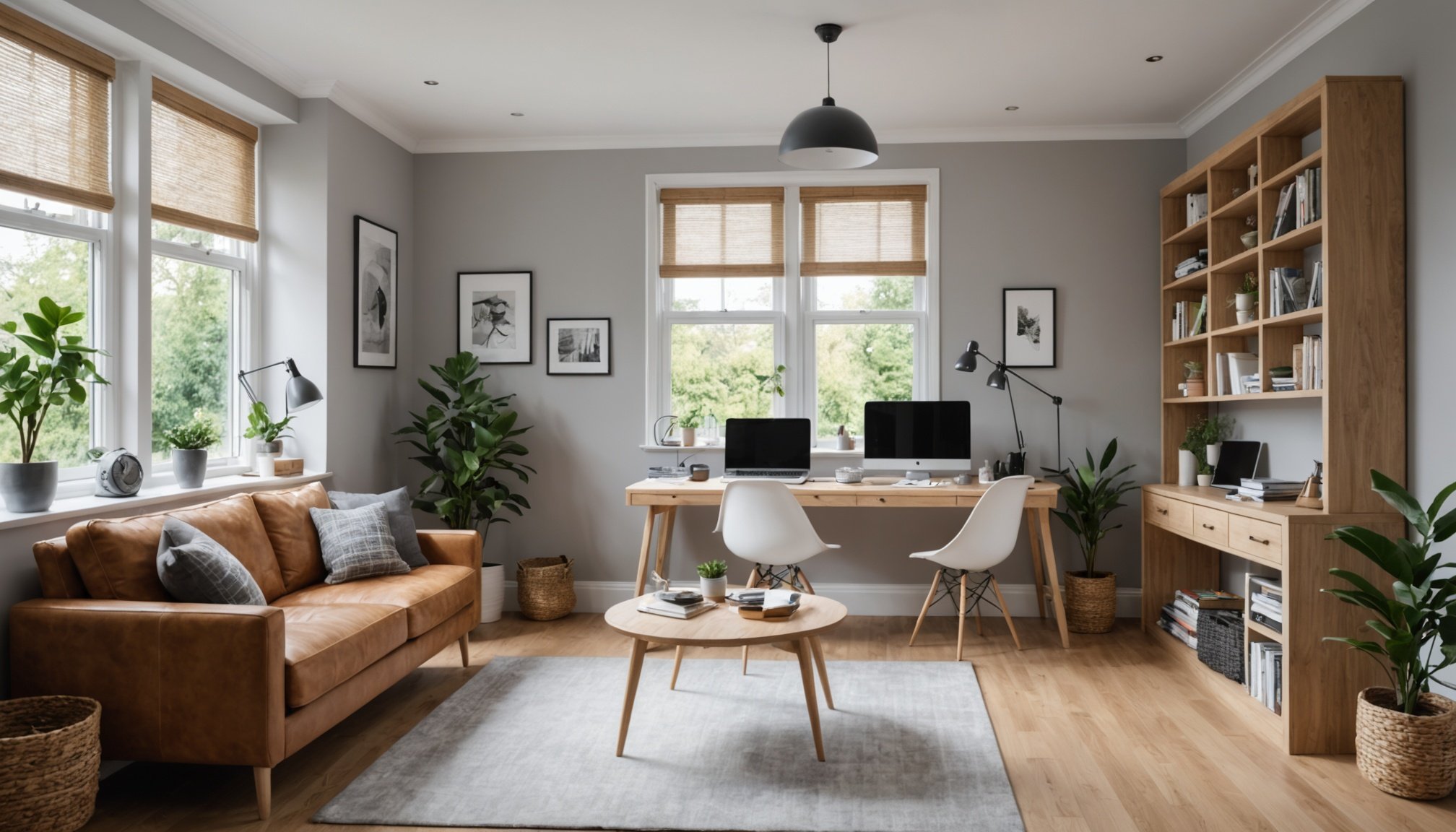Understanding Remote Work Needs
Remote work has fundamentally changed our living spaces, particularly for UK homeowners with home office requirements. Adapting to these changes can be challenging. Remote workers face common issues in UK homes, such as lack of space, inadequate equipment, and poor lighting, all of which disrupt productivity. Recognising these challenges is the first step in transforming the home environment.
Meeting one’s remote work needs requires tailoring the home office to fit individual work styles. This means considering both physical space and psychological comfort. UK homeowners often need to balance a professional work area with personal living space, which can be difficult when spaces are small. The layout of a home office can critically impact work efficiency and mental health.
Also read : Navigating UK Short-Term Rental Laws: Comprehensive Insights
To address these needs effectively, homeowners must understand the key elements of a home office. These include not only physical items like desks and chairs but also softer elements like colours and decor that promote focus and creativity. By analysing individual work styles and considering practical elements like ergonomics, UK homeowners can optimise their home offices, thus enhancing both job performance and overall well-being. Tailoring your environment is essential to thrive in a remote work setting.
Space Organization Strategies
Creating an organised and efficient home office setup can significantly boost productivity for UK homeowners facing remote work needs. This starts with addressing clutter, the nemesis of productivity. Declutter your workspace by identifying what is essential and storing away non-essential items. A clean environment fosters concentration, reducing mental distractions.
Also to read : Maximizing Returns: The Financial Perks of Investing in Real Estate Near UK Film Studios
Consider the use of multi-functional furniture to maximise your space. Furniture that serves more than one purpose can free up room otherwise occupied by multiple pieces. For instance, a desk with built-in storage or a foldable table that doubles as a meeting space enhances functionality without occupying excess floor area.
Creating designated work zones within the home helps set boundaries between work and personal time. Use different parts of your home to serve different purposes. For example, the kitchen table could temporarily transform into a meeting hub, while a corner nook with a compact desk serves as your daily workstation. This approach delineates work and leisure areas, aiding in maintaining focus and distinct work-life separation.
By implementing these space organization strategies, UK homeowners can develop an efficient and motivating home workspace suited to both professional demands and personal comfort.
Ergonomic Furniture Recommendations
Finding the right ergonomic furniture is crucial for maintaining comfort and health while working from home. Prolonged sitting can strain the body, so it’s essential to have a chair and desk that support proper posture. Ergonomic designs help distribute body weight evenly, reducing pressure on the spine and promoting a more natural seated position. The UK homeowners should consider investing in chairs that offer adjustable height, lumbar support, and recline options to suit different body types and work styles.
For the desk, look for height-adjustable features that allow for both sitting and standing postures. This flexibility can prevent the fatigue associated with static positions. Desks with ample surface area and cable management solutions can further enhance remote work environments by keeping workspace clutter-free and organised.
In addition to the main furniture pieces, accessories like ergonomic keyboards and mice are integral to improving comfort. These items reduce the risk of repetitive strain injuries by providing a more natural hand and wrist position during use. A well-considered selection of these elements can significantly enhance the comfort solutions of a home office, ultimately supporting both physical health and productivity for UK homeowners during their work-from-home routines.
Optimizing Lighting for Productivity
Proper home office lighting can substantially impact productivity and overall work satisfaction for UK homeowners. The integration of natural light into your workspace is essential, as it has been shown to bolster mood and efficiency. Position your desk near a window to harness daylight, which can help regulate circadian rhythms and enhance focus.
Artificial light also plays a crucial role, especially in rooms with limited sunlight. Best practices include layering different types of lighting. For instance, a blend of ambient lighting, task lighting, and accent lighting creates a balanced environment. Ambient lighting provides general illumination, like overhead lights or floor lamps. Task lighting focuses on specific areas that require more light, ideal for reading or computer work, such as desk lamps. Lastly, accent lighting adds depth and warmth, contributing to a motivating atmosphere.
Consider using LED bulbs, which offer energy efficiency and customizable brightness levels. Also, pay attention to colour temperature; cool white light can promote alertness, while warm white is soothing. For ultimate productivity enhancement, experiment with smart lighting options that adjust throughout the day to mimic natural light patterns, supporting a conducive work environment.
Decor Ideas to Inspire Creativity
Creating an inspiring and aesthetically pleasing home office decor can significantly influence the productivity of UK homeowners. Selecting the right colours is crucial for enhancing creativity and focus. Calming hues like blues and greens foster concentration, while pops of yellow or orange can spur creativity and energy. Avoid overly bright or distracting shades that might impede focus.
Personalisation fosters a sense of ownership and inspiration in a workspace. Integrate art pieces that resonate personally or motivate productivity. Incorporating plants not only enlivens the space but also improves air quality, which can contribute to a more refreshing work environment.
Decor can also play a key role in creating a calming atmosphere. Consider textures and materials that promote relaxation, like soft fabrics or natural wood finishes. Use small but impactful items such as elegant organisers to keep clutter in check while adding to the workplace’s visual appeal.
Integrating these essential elements into your home office decor can transform a mundane setup into an engaging and inspirational space. By tailoring the aesthetics to one’s personal preferences and work style, a home office can become more than just a place to work—it becomes a personalized haven for productivity and creativity.
Practical Examples and Checklists
Transforming your remote work setup can be manageable and rewarding for UK homeowners by using practical examples and implementing effective home office checklists. Start by examining successful remote office setups tailored to varying needs. For instance, a minimalist may prioritise a clutter-free environment with essential ergonomic furniture, while a creative worker might utilise colourful decor and flexible layouts.
Creating a detailed checklist ensures all necessary equipment and organisational tools are accounted for. Essential items include an ergonomic chair, adjustable desk, proper lighting, and quality tech accessories like noise-cancelling headphones. This comprehensive approach allows for creating a conducive work environment.
Local resources can offer convenient solutions and cater to specific needs. UK retailers provide a range of products from multi-functional furniture to energy-efficient lighting options, facilitating a seamless home office transformation.
Finally, remember to adapt your setup guide to fit your unique requirements and preferences. This flexibility prevents one-size-fits-all solutions and promotes a personalised, efficient workspace that supports productivity and well-being. Implementing these practical strategies ensures a functional, inspiring remote work environment.
Maintaining Work-Life Balance
Understanding work-life balance is crucial for UK homeowners managing remote work. An effective strategy involves setting clear boundaries between your professional and personal spaces. One practical tip is designating a specific area in your home solely for work, which helps to separate work from leisure physically.
Integrating time management techniques can alleviate the blend of work and home responsibilities. Use tools like digital calendars to schedule tasks and allocate time for breaks. This practice ensures productivity while preventing burnout. Structuring your day with defined start and end times for work creates a semblance of a traditional office routine.
The importance of breaks cannot be overstressed. Incorporating several short breaks throughout the day aids in maintaining focus and sustaining energy levels. Engage in recreational activities during these breaks to refresh your mind. Having a dedicated recreation space in your home, like a reading nook or a mini gym, offers a necessary diversion and supports mental well-being.
Small adjustments make a significant impact. Tailoring your routines and surroundings to fit your lifestyle not only supports a balanced work-life but also enhances overall productivity and satisfaction for remote workers. Keep exploring personal adaptations to maintain equilibrium in your day-to-day life.

